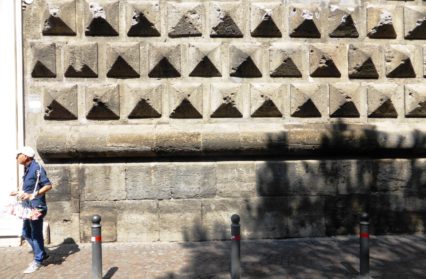Richard Porch delivers a powerful travelogue on the theme of the fear of the city.
It is generally understood that fear is learned and not simply hardwired into our genes. We learn to be afraid. I know this to be true because I’m frightened of things now that I was not afraid of as a ten year-old. It comes via experience (or the lack of it) but is often passed on by others relating bad experiences, personal superstition and what people think you should be afraid of. This is often dressed up as a warning or ‘good advice’ despite the fact that frequently the person giving the warning / advice may have no direct experience of it. The net result is fear nevertheless.
Cities are good at inducing fear; especially ones that you have never visited before and know of only by reputation. A whole range of products have come into existence to support this fear. Money belts and wallets that can be worn around the waist or inside the trousers, advice about how to carry shoulder bags and whether or not to wear an expensive watch, etc. Some of it is common sense but too much will have you travelling around only in a protective phalanx that forms should a foreigner ever approach you. Eventually this will stop you going to certain places altogether, this has happened to me too.
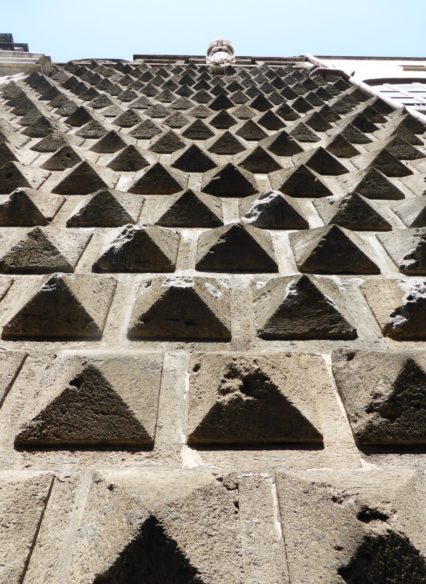 I can well remember the first time I went to live in London in the early 1980s and emerged from Paddington Station into Praed Street in a state of great apprehension. Everything posed a problem; the tube (terrifying in its sheer complexity), taxis (the etiquette behind giving tips) and even the big Routemaster buses (the squash involved in merely getting on them in the rush-hour) made living there seem like one big ordeal. The answer was of course that via day-to-day experience one does eventually master all of those fears. It didn’t help that I arrived there with a battery of prejudices. Most of which were shaped by visual impressions of how the place looked in various films and on television. This was buttressed by tales from folk whose experience of London was of literally the away-day variety. It produced a malignant timidity that found its expression (at least initially) in being extremely wary of everyone and everything.
I can well remember the first time I went to live in London in the early 1980s and emerged from Paddington Station into Praed Street in a state of great apprehension. Everything posed a problem; the tube (terrifying in its sheer complexity), taxis (the etiquette behind giving tips) and even the big Routemaster buses (the squash involved in merely getting on them in the rush-hour) made living there seem like one big ordeal. The answer was of course that via day-to-day experience one does eventually master all of those fears. It didn’t help that I arrived there with a battery of prejudices. Most of which were shaped by visual impressions of how the place looked in various films and on television. This was buttressed by tales from folk whose experience of London was of literally the away-day variety. It produced a malignant timidity that found its expression (at least initially) in being extremely wary of everyone and everything.
Art didn’t help either. I only compounded my fear of what I was going to find by looking for reassurance in the work of favourite artists like Edward Hopper, the acknowledged master of portraying urban alienation on canvas. His painting ‘Approaching a City (1946) is a masterpiece of his oeuvre that captures unerringly the ordeal behind arriving in a new city for the first time by train. The hostile blankness of nearby buildings and the lives lived by the occupiers (none of whom you know). The sheer otherness of everything and one’s lack of knowledge about how to overcome it. In this painting Hopper devotes nearly half of the canvas to the entrance to a tunnel and the blank concrete wall approaching it. It personifies apprehension. It’s as if he’s saying ‘the tunnel is the future and who knows where it is going to take you’. Inspired by the use of a painting by Giorgio De Chirico called ‘The Enigma of Arrival’ on the cover of a novel of the same name by V.S. Naipaul’ (and ever the glutton for punishment) I was moved to look at a book of the artist’s paintings. Bad move. De Chirico’s moody metaphysical landscapes are full of empty meaning. Something is going on within them, but a combination of deep shadow, distracting perspective and the deployment of towering, austere architecture hemmed in by high walls conspires to deny rational explanation or understanding. You are a perennial outsider and this is your (hopefully) temporary fate when you go to a new city.
But then I suppose it depends on the city you are going to. I can recall travelling alone to Tokyo in the late 1980s and relished the prospect. Was it the fact it had a good reputation in terms of crime, the streets seemed wide and modern and the inhabitants were (by reputation) incurably polite? Quite possibly. Even back then Tokyo’s greater metropolitan area was home to 30+ million people of which 13 million lived at its centre. The latter was ringed by a belt of suburban housing that stretched to the horizon in every direction with each individual property seeming only to be the size of a small caravan. This place was going to be crowded. It was densely packed with people and vast in size and complexity, but it was relatively easy to negotiate oneself around. Landmarks presented themselves at every turn. Whether it was the architecturally-scaled advertising above most retail buildings or a sudden precinct of temples, it was a city you could come to terms with quickly. No dark alleys or obvious no-go zones to the stranger. There was nothing apparently to fear; perhaps it was because the city appeared ‘legible’? Tokyo had the Imperial Palace at its centre which, unlike many European examples, then largely denied access to the visitor and was therefore a vacuum at the heart of the world’s most populous cities. This didn’t strike me as odd and I think I even respected it. I respected its other anomalies too. In the late 1980s Tokyo was a world centre for innovation in the electronics manufacturing industries and where most new electronic products first saw the light of day.
Nevertheless when the Japanese in central Tokyo wanted to relax they bafflingly turned to Pachinko parlours. These were very old fashioned-looking amusement arcades with row after row of crude, non-electronic machines which operated on a variation of the bagatelle principle. It was a kind of vertical pinball played by manually flicking small ball bearings using a spring-loaded trigger up the face of a board whose face was covered in gates and barriers that could deflect the ball bearings in to holes and hence trigger the release of more ball bearings into a small plastic tray or paper cup. If you were successful at accumulating enough by this means, you could exchange them like tokens for soft toys or sweets, etc. from the operator of the parlour. By now Pachinko has been both digitised and ‘weaponised’ as a tool of the modern gambling industry. To wander Tokyo in the late 1980s and see Pachinko parlours full of office workers playing this almost child-like game somehow made me feel very safe. Despite being the burgeoning centre of the world electronics industry when its inhabitants wanted to unwind after a long day’s work they flicked 11mm diameter ball bearings around a vertical pinball-like board. How bad could they be? The secret was I suppose to be in there and amongst them.
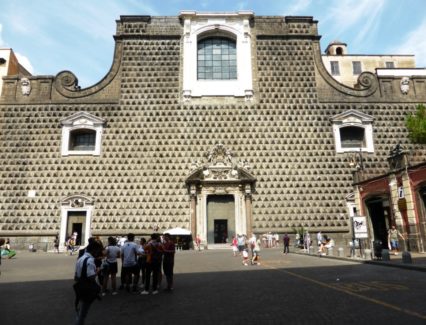 I re-learnt all this again very recently after visiting Naples for the first time. Having visited Italy twice before I passed up on two chances to visit the city and preferred instead to look at more picturesque things such as the Amalfi coast and Roman ruins that everyone goes to at Pompeii and Herculaneum. My long-range impression of Naples was that it was dangerous, rough and not worth the effort even though it was only an hour from where I usually stayed. This impression was formed by Internet blogs that recounted harrowing stories about theft, pick pocketing and organised crime. All of this still held powerful sway until something else crowded it off the agenda. I wanted to see a particular building there. The fact it was in one of Naples busiest inner-city areas with competing reputations for atmosphere and ‘dodginess’ suddenly became almost an attraction. A positive variation on the tourist mantra ‘See Naples and Die’. So, if fear can’t be un-learnt – perhaps it can at least be overridden.
I re-learnt all this again very recently after visiting Naples for the first time. Having visited Italy twice before I passed up on two chances to visit the city and preferred instead to look at more picturesque things such as the Amalfi coast and Roman ruins that everyone goes to at Pompeii and Herculaneum. My long-range impression of Naples was that it was dangerous, rough and not worth the effort even though it was only an hour from where I usually stayed. This impression was formed by Internet blogs that recounted harrowing stories about theft, pick pocketing and organised crime. All of this still held powerful sway until something else crowded it off the agenda. I wanted to see a particular building there. The fact it was in one of Naples busiest inner-city areas with competing reputations for atmosphere and ‘dodginess’ suddenly became almost an attraction. A positive variation on the tourist mantra ‘See Naples and Die’. So, if fear can’t be un-learnt – perhaps it can at least be overridden.
Naples does not have the socio-cultural cachet of Milan or Turin but is nevertheless the third largest city in Italy. It was founded by the Greeks in the 6th century BC as Neapolis (‘New City’) and merged successfully with the Roman Empire becoming a key cultural centre within it. It survived the fall of that empire and became the capital city of the Kingdom of Naples between 1282 – 1816. It was also the most bombed Italian city of World War 2. It attracted my interest because it is one of the most continuously-occupied cities in the world, as is borne out by even the most cursory glance at its inheritance of architecture and public spaces.
I wanted to see the Gesù Nuovo which is a baroque church built originally as the Palazzo Sanserverino in 1470. The family that owned it were penalised for political intriguing by having it confiscated and it was bought by the Jesuits who commissioned Giuseppe Veleriano (1542 – 1596) to build them a church. Construction started in 1584 and the highly distinctive main facade that looks out onto Piazza Del Gesù Nuovo was retained. The building was originally a fortified family palace and to this end was covered with curious conical stone ‘teeth’ that gives this principal facade a curiously militaristic carapace. By way of contrast it has a 17th century classical doorway which was the original Renaissance entrance from the street and admits the worshipper or visitor. This has a humanising effect on what is otherwise a forbidding exterior.
Contrast is the name of the game with this building. The uninitiated passerby or tourist sees the diamond-point rustication carved in ashlar and thinks this is some sort of redundant medieval fortification. Instead upon entering one is struck by the richly baroque religious interior which assaults the visual senses with a torrent of colour, form and religious imagery. Every surface is richly coloured except for the congregation’s varnished timber pews and the visitor is visually overwhelmed by the opulent marriage of painting, sculpture and classical architecture in true baroque style.
I wanted to see the church’s main elevation because I am interested in it as an example of vermiculate rustication, which I believe to be an invention of the baroque. Gesù Nuovo can be found in the Piazza Del Gesù Nuovo where Galata Trinita Maggiore meets Via Benedetto Croce. These streets and public spaces are themselves part of the ‘Spaccanapoli’ (Naples splitter). This is a long, straight road which was originally one of the main east-west thoroughfares (Decumanus Inferiore) of Greco-Roman Naples. You can see it best in aerial photographs which show it as a narrow black line against the surrounding architecture which cuts or splits the city along its length, hence its name. Spaccanapoli has to be one of the great streets of the world if you want an intense urban experience comprised of a fusion of dramatic classical churches, public squares and historic structures. Seeded densely in amongst these are shops, cafes and restaurants of wildly varying quality. Energise the narrow street with a steady flow of tourists, inhabitants and traders and you have Spaccanopoli. It has so many churches designed in the grand classical manner which front a street that is no more than a wide lane capable of accommodating about ten people in line abreast. Some of the places are places of worship others have been given over to retail space. Always there are people on mopeds or scooters wandering in and out of the mass of street users.
Because it has such a long length the street can be divided into numerous sections. The modern start of it is the Gesù Nuovo and it takes in Via Benedetto Croce, Via S. Biagio Dei Librai it then crosses Via Duomo before moving beyond the confines of the old town centre. Of these ancient Greco-Roman east-west roads there are two more above it buried in the fabric of the modern city. The one immediately above Spaccanopoli is now the Via de Tribunali and the most northerly of the three is now Via Anticaglia and Via della Sapienza. If one looks at these three horizontal streets and the corresponding north-south streets piercing them vertically on any street map, you are looking at the grid of the old Greco-Roman city of antiquity. Truly the city as palimpsest.
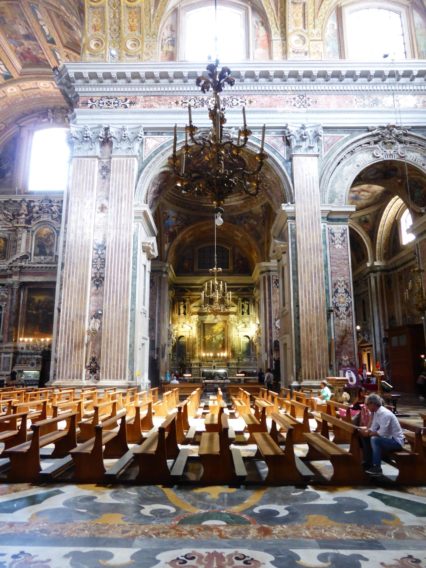 We arrived in Naples at the Garibaldi Railway Station, a place so besieged with people, traffic and noise that one’s first instinct is to flee the place on foot or by car. Our taxi driver dropped us at the far end of the Via Vicaria Vecchia and we began to walk along the Spaccanapoli looking tentatively for the distinctive ‘spikey’ facade of the Gesù Nuovo. One is immediately struck by the narrowness of the place, the ‘distressed’ nature of the surrounding buildings and the way other little lanes feed into it. These often have disturbingly eerie names like “Vico Del Fico Al Purgatorio” (The Alley of the Fig tree of Purgatory) the entrance to such alleys often looks highly disreputable and dangerous with loose brickwork and masonry. You don’t feel encouraged to walk down them – even in broad daylight. Interestingly, in Catholic theology purgatory is supposed to be an intermediate or halfway point between earth and hell. After physical death the soul has to undergo a purification process to achieve the holiness required to enter heaven where some sins can be forgiven and others dealt with at the next stage. What a fantastic freight of literary-religious baggage to attach to a mere alley. Anyone tempted to use it to escape the sheer press of people on Spaccanapoli are put off just by its appearance. If not actually fear-inducing then it at the very least makes you apprehensive about using it. There is a small amount of thin Roman brickwork to its entrance and the rest is stone which has weathered badly to a bizarre almost molten effect. The roof over it is a small diameter barrel vault which has been stained black by hundreds of years of lack of maintenance. Underfoot is the standard paving everywhere on the Amalfi coast, the black volcanic rock Tufa with a crudely-hammered finish. The net effect is decayed and dangerous; one imagines only locals using it. So, the emotion of fear can help define access to public and semi-public space. Even if you change the name of the alley to something more saintly it does not seem to affect one’s desire to use it. There is a Vico San Nicola a Nilo (Alley of St. Nicola of the Nile) which is almost a carbon copy of Vico Del Fico Al Purgatorio. It too possessed that highly distressed look that deters use and appears to have been eaten away rather than created as a secondary footpath through a building plot. That such alleys are usually poorly lit (where they are lit at all) and the narrowness of the main thoroughfare beyond means that a sinister half-light prevails inside them. All it then takes is for a few hapless locals to gather in one passing the time of day or eating the famed local pizza and an inadvertent air of menace or danger is generated. Yet another level of fear.
We arrived in Naples at the Garibaldi Railway Station, a place so besieged with people, traffic and noise that one’s first instinct is to flee the place on foot or by car. Our taxi driver dropped us at the far end of the Via Vicaria Vecchia and we began to walk along the Spaccanapoli looking tentatively for the distinctive ‘spikey’ facade of the Gesù Nuovo. One is immediately struck by the narrowness of the place, the ‘distressed’ nature of the surrounding buildings and the way other little lanes feed into it. These often have disturbingly eerie names like “Vico Del Fico Al Purgatorio” (The Alley of the Fig tree of Purgatory) the entrance to such alleys often looks highly disreputable and dangerous with loose brickwork and masonry. You don’t feel encouraged to walk down them – even in broad daylight. Interestingly, in Catholic theology purgatory is supposed to be an intermediate or halfway point between earth and hell. After physical death the soul has to undergo a purification process to achieve the holiness required to enter heaven where some sins can be forgiven and others dealt with at the next stage. What a fantastic freight of literary-religious baggage to attach to a mere alley. Anyone tempted to use it to escape the sheer press of people on Spaccanapoli are put off just by its appearance. If not actually fear-inducing then it at the very least makes you apprehensive about using it. There is a small amount of thin Roman brickwork to its entrance and the rest is stone which has weathered badly to a bizarre almost molten effect. The roof over it is a small diameter barrel vault which has been stained black by hundreds of years of lack of maintenance. Underfoot is the standard paving everywhere on the Amalfi coast, the black volcanic rock Tufa with a crudely-hammered finish. The net effect is decayed and dangerous; one imagines only locals using it. So, the emotion of fear can help define access to public and semi-public space. Even if you change the name of the alley to something more saintly it does not seem to affect one’s desire to use it. There is a Vico San Nicola a Nilo (Alley of St. Nicola of the Nile) which is almost a carbon copy of Vico Del Fico Al Purgatorio. It too possessed that highly distressed look that deters use and appears to have been eaten away rather than created as a secondary footpath through a building plot. That such alleys are usually poorly lit (where they are lit at all) and the narrowness of the main thoroughfare beyond means that a sinister half-light prevails inside them. All it then takes is for a few hapless locals to gather in one passing the time of day or eating the famed local pizza and an inadvertent air of menace or danger is generated. Yet another level of fear.
Sometimes this is justified though. I can remember when I lived in London there was a run of retail units on my route home that contained a kebab shop that I had to walk past. It was owned by a very touchy guy who, if he saw you glance in and make eye contact with him, would rush out with a carving knife and act as if he was going to chase you down the street. The first time this happened to me I ran off in fear of my life and then altered my route home for a week after. Fear can change circulation patterns. A few weeks later I resumed my old route and when inevitably we made eye contact again and he came charging out brandishing his knife, I simply shrugged my shoulders and calmly walked on. I had become immune to that particular fear. The effects of terrorism whether by bomb or vehicle attack have this same sort of trajectory. People are understandably reluctant to use the venue of a terrorist attack in the immediate aftermath of an atrocity. Time passes however and they soon begin to reuse the scene and the passage of time plus sheer esprit de corps hardens the consciousness against that very fear. Fear becomes governable.
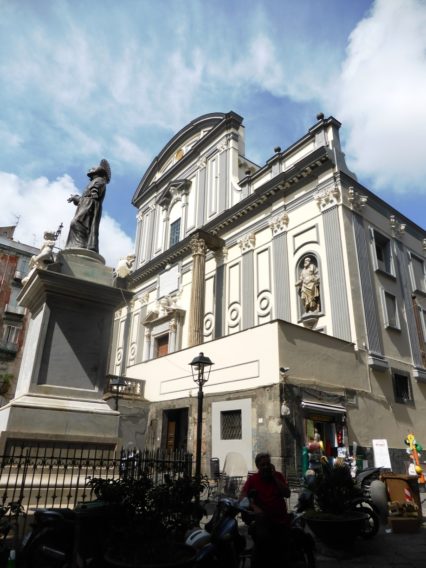 Back in Spaccanopoli. We walked down Via Benedetto Croce stopping to take in San Domenico Maggiore sitting within the Piazza of the same name. It is a distracting feature of Spaccanapoli that some of the churches have their spires (Guglia in Italian) sitting in the piazza across the way from the building, rather than atop it. In doing this they do not read as detached bits of a building, more as impressively ornate pieces of sculpture or obelisks and therefore operate as useful landscape / orientation features. If one adds the bell tower for Santa Chiara and the two Guglia one can see the all-pervasive impact of religion on Spacconapoli’s landscape. Is this about putting the fear of God into people? The Gesù Nuovo was redeveloped by the Jesuits; they were also responsible for the Guglia dell’ Immacolata which dominates the Piazza Del Gesù Nuovo. The first stone of the bell tower of the Santa Chiara convent and church was laid in 1310 by Robert of Anjou (1275-1343) the King of Naples. The obelisk in the Piazza San Domenico is something Hawksmoor would have been proud of and was commissioned to celebrate the city’s emergence from the plague outbreak of 1656. Guglia or obelisks are normally adorned by Catholic religious motifs and subjects such as saints and stories to do with the Virgin Mary, as in the case of the Guglia dell ‘Immacolata. Fear and religion make for powerful bedfellows.
Back in Spaccanopoli. We walked down Via Benedetto Croce stopping to take in San Domenico Maggiore sitting within the Piazza of the same name. It is a distracting feature of Spaccanapoli that some of the churches have their spires (Guglia in Italian) sitting in the piazza across the way from the building, rather than atop it. In doing this they do not read as detached bits of a building, more as impressively ornate pieces of sculpture or obelisks and therefore operate as useful landscape / orientation features. If one adds the bell tower for Santa Chiara and the two Guglia one can see the all-pervasive impact of religion on Spacconapoli’s landscape. Is this about putting the fear of God into people? The Gesù Nuovo was redeveloped by the Jesuits; they were also responsible for the Guglia dell’ Immacolata which dominates the Piazza Del Gesù Nuovo. The first stone of the bell tower of the Santa Chiara convent and church was laid in 1310 by Robert of Anjou (1275-1343) the King of Naples. The obelisk in the Piazza San Domenico is something Hawksmoor would have been proud of and was commissioned to celebrate the city’s emergence from the plague outbreak of 1656. Guglia or obelisks are normally adorned by Catholic religious motifs and subjects such as saints and stories to do with the Virgin Mary, as in the case of the Guglia dell ‘Immacolata. Fear and religion make for powerful bedfellows.
I then came upon the Gesù Nuovo obliquely and saw its principal facade faced in small ashlar pyramids soared like rows of rugged teeth above me. These climb the frontage giving it a stony faceted appearance. This frontage dwarfs passersby, presumably as it was intended to. The rustication is stopped at roughly head-height above the pavement by a radiused string-course of stone which in turn rests on two courses of crudely cut blocks. So crudely executed are they that some are square and others rectangular; all have been defaced by graffiti. One imagines these courses work to keep people away from the rusticated blocks and visually gives the building a thin workaday plinth on which to rest. The result makes the sheer cliff-face of pyramidal rustication look even more impressive and menacingly heavy. I hung around outside taking this facade in from both acute and oblique angles enjoying the resolutely defensive majesty of the facade being offered to the world. Instinctively one expected that once inside this was a building that would protect you.
The interior is almost a definition of what baroque is and explodes upon your senses working almost as compensation for the grim military exterior. The Baroque isn’t to my taste; the coating of every vertical and horizontal surface with a rich veneer of decoration offends my uptight northern European sensibility. Nevertheless, one has to admire the sheer exuberance and self-indulgence of it all even if it is religiously driven. Perhaps the best way to appreciate it is as a kind of art gallery that uses the very fabric of the architecture as a three-dimensional canvas and all the art is applied to that. It is one of the most completely designed environments you will ever experience. Every square inch of it looked as though someone had mulled over the effect required, as a result it also screams extreme wealth at you too.
One exits the building and returns back to the hard light and still harder streets of the Spaccanapoli where the procession of people walking by is unceasing. If you see it in aerial photographs Spaccanapoli looks like an arbitrary black line drawn through the fabric of Naples. From which on either side spreads out a rich carpet of urban architecture dating from the 1200s up to later insertions. It does not have in any sense a ‘modern’ impact with dramatic insertions of the kind one sees in Tokyo. Rather it is the re-use of old buildings which are animated by the new users which provides the interest. That thin black line was first laid out firstly by some Greek surveyor and then consolidated by the Romans. It is there now for the tourists, native Neapolitans and the young who flock there for the vibe of the place. And what is that vibe? It can be expressed as an admixture of vitality, activity and atmosphere and all achieved without recourse to a mall or shopping centre. In the end I didn’t find it threatening; you have to be careful – no more though than in lots of comparably busy streets in inner-city London. Perhaps if you can focus on one of the many layers of interest that Naples offers such as religion, architecture, art or food (in Spaccanapoli all on one street) then you stand a fighting chance of sublimating your fear of the city’s feral side and engage with it. Despite it being the capital of tourist-hungry southern Italy and located on the fertile Campania plain, it is still a place where you can eat and drink inexpensively by comparison with Rome or even nearby Sorrento.
For all the dire warnings of street crime and devilment, Spaccanapoli has to be one of the great streets of the world. Would I go there again? Yes I would and I would recommend it to anyone interested in seeing how people make places as much as architecture or public space.


